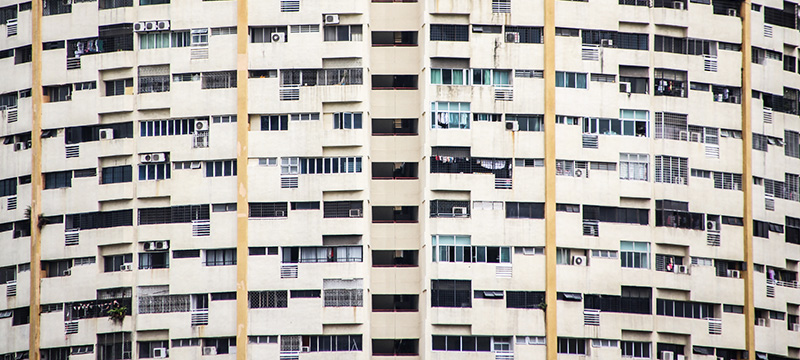In the 21st century, the proliferation of technology has empowered individuals and organisations alike. Within this technological surge, the Internet of Things (IoT) is increasingly paving the way for transformative changes in various sectors, including UK social housing.
A long-standing issue this sector has been dealing with is damp and mould; both from a regulatory point of view but more importantly from a resident health perspective. The rapid adoption of IoT in UK social housing, however, is ushering in a new era, helping to more effectively address these issues. Technology-enabled solutions such as environmental sensors that measure temperature, humidity, and CO2, along with fire and carbon monoxide alarms, are becoming increasingly common. These IoT devices not only detect potential problems but also enable predictive maintenance, offering landlords the ability to proactively tackle issues before they escalate.
This technological shift is also promoting strategic resource allocation by housing providers, allowing them to prioritise based on the severity of issues. Essentially, it’s a paradigm shift, creating a proactive rather than a reactive approach towards identifying serious damp and mould issues: this is what the Housing Ombudsman refers to as “finding your silence”. This not only saves money for landlords in the long term but more importantly reduces the distress caused to residents due to these recurring problems.
For residents, the benefits are immense. Healthier living conditions are a key outcome of this technological integration, offering a safer environment and contributing towards a more sustainable future.
Scale of the Problem: The Impact of Damp and Mould
While the benefits of the IoT revolution are promising, it’s essential to understand the scale and impact of the issue at hand. Damp and mould are not simply an aesthetic problem, but they have serious health implications. According to Shelter, an organisation dedicated to housing issues, approximately one million rented homes in England alone are plagued by serious damp problems.
The health implications of living in a mould-infested house are severe. Research suggests that exposure to mould can exacerbate breathing problems and lead to the development of asthma, particularly in children.. There are also suggestions that it can contribute to the development of serious conditions such as dementia. Furthermore, the psychological impact of living in such conditions should not be underestimated, with studies indicating a clear link between damp, mouldy living conditions and mental health issues.
What is even more distressing is that these issues disproportionately affect the vulnerable segments of the society — children and the elderly. As homes are increasingly retrofitted to be more energy-efficient and sustainable, there’s also a risk that these issues might escalate if proper ventilation is not ensured, thereby causing a decrease in indoor air quality.
Recent Events: The Cry for Change
Recent years have seen an increasing public outcry regarding substandard living conditions, resulting in an escalating number of news stories highlighting the struggles of residents. With the recent tragic and avoidable death of 2 year old Awaab Ishak, this issue finally led to formal letters from the UK Regulator of Social Housing and the Secretary of State for Housing, demanding landlords to address this problem. Alongside this, the Housing Ombudsman has stepped forward with a set of guidelines to manage and mitigate the impact of damp and mould.
Guidance from the Ombudsman: A Beacon of Hope
The original ‘Spotlight on Damp and Mould’ report by the Housing Ombudsman highlighted the severity of the issue and the necessity of a focused, strategic response. The report calls out a culture of blame and inadequate responses to issues of damp and mould.
The updated guidelines from the Ombudsman include:
Taking a proactive approach rather than simply reacting (sub optimally) to complaints. Change organisational culture to one of accountability rather than blame. Think in terms of resolving damp & mould issues rather than claim handling.In the follow up report in February of this year the Ombudsman went further to highlight good practice including:
Humidity and temperature sensors Specialist damp & mould teams Root cause analysis modelling Dedicated damp & mould dashboard Staff training Dedicated apps for reporting issuesThe guidelines already specifically advocate the use of temperature and humidity sensors in homes. These sensors would serve as an early warning system, flagging when a property is at risk of mould growth. Moreover, the Ombudsman emphasises the use of data gathered from these sensors for predictive modelling. This could potentially allow housing providers to proactively identify properties at risk, preventing the onset of severe damp and mould issues. In addition, the Ombudsman encourages equipping surveyors with advanced equipment to identify cold spots and areas of high thermal bypass, thereby enhancing the efficacy of inspections and interventions.
The Crucial Role of Sensors
In the battle against damp and mould, sensors are becoming increasingly crucial. As per retrofit standards such as PAS 2035, EESSH 2, and ORP in Wales, the implementation of sensors are highlighted as good practice in ensuring homes perform as expected post ‘intervention’, whether maintenance or retrofit measure, and that there are no unintended negative consequences such as worsened indoor air quality and humidity. These sensors, strategically installed in common problem areas such as kitchens, bathrooms, living rooms, and bedrooms, can help pinpoint sources of potential issues.
Newly developed mould algorithms can predict the likelihood of mould growth, acting as an early warning system for property owners and residents. Aico-HomeLINK have gone one step with the invention of the SvE algorithm – a world-first – that predicts the underlying root cause of the issue, whether it’s lack of adequate ventilation, a potential leak, or other contributing factors.
Once the root cause is identified, appropriate interventions can be implemented, such as replacing a faulty ventilation system or fixing a leak. Post-intervention, the same sensor data can be used to evaluate the effectiveness of the solution. As Martyn Cheeseman of Grand Union Housing Group aptly put it:
“We validated the effectiveness of new ventilation systems we are installing to resolve condensation, damp and mould issues. Real-time data insights provided via the HomeLINK Portal make it very simple for us to make informed decisions on the future specification of fans that are proven to be effective in the treatment of humid and damp living conditions.”
The Future of Housing: IoT at Scale
This technological revolution embodies the potential of IoT at scale. It is akin to having a Fitbit for your home, constantly monitoring and providing real-time insights into its health. The scale of this revolution is evident from the fact that already 220,000 Aico-HomeLINK devices are connected in UK social homes, with an ambitious target of reaching 1 million by the end of 2024.
This large-scale deployment of IoT not only solves the immediate issues of damp and mould but also sets a precedent for a more technologically integrated future for housing. The positive implications extend beyond individual households, leading to significant improvements in public health and by extension reducing pressure on the NHS.
In conclusion, the adoption of IoT in UK social housing represents a crucial step towards healthier, safer, and more sustainable living conditions. As sensors become integral to our homes, just like they already are with our cars, we are entering a future where our homes can warn us about potential health hazards, thereby contributing significantly to improving our quality and longevity of life.
The post Is The Internet of Things A Game-Changer in Tackling Damp & Mould in Social Housing? appeared first on IoT Business News.
























